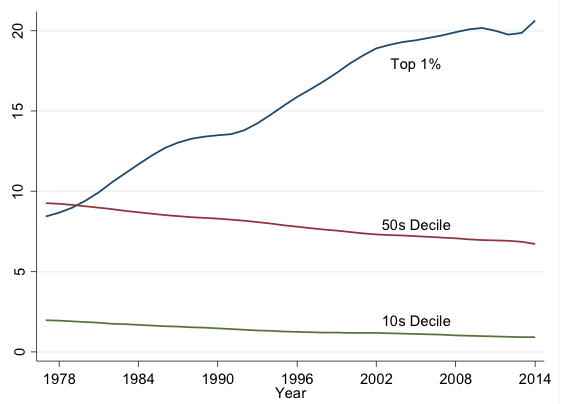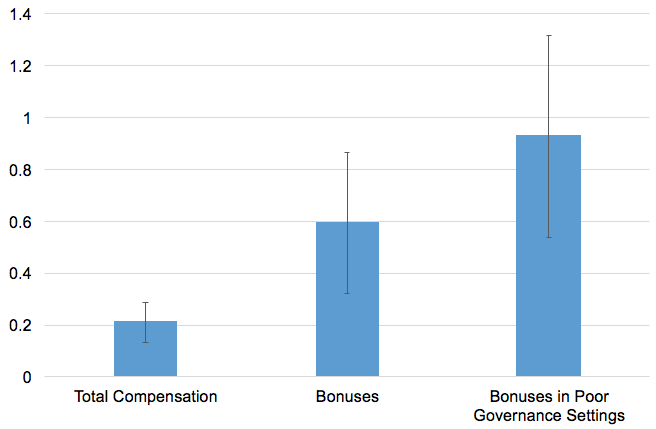所得格差の拡大は、過去数十年で先進諸国の特徴的な現象となった。この傾向の要因については多くの実証研究があるが、グローバル化の役割についての分析はほとんどない。本稿は役員報酬に関する米国のデータを用いて、企業規模、技術、不十分なガバナンスのみならず、グローバル化も最富裕層の所得増加の要因となっていると述べる。
格差拡大は、過去40年間にわたって米国経済の最も顕著な特徴の1つである。図1は、格差拡大は、最富裕層の所得が急増したことによってほぼすべて説明できることを示している (Alvaredo et al. 2017, Piketty and Saez 2003)。上位1%の富裕層の所得のシェアは、1970年代には10%未満だったが、現在では20%以上である。重要な政策的含意を持っているにもかかわらず、最富裕層の所得増加の原因はいまだに解明されておらず、議論が続いている。

説明
最富裕層の所得が急増している理由に関しては、さまざまな説明がなされている。たとえば企業規模の拡大(Gabaix and Landier 2008)、新しい技術 (Kaplan and Rauh 2013)、スーパースターの市場(Rosen 1981)、不十分なガバナンス(Bertrand and Mullainathan 2001)、最高税率の変更(Piketty et al. 2014)などである。一般的に、グローバル化が最富裕層の所得増加に一定の役割を果たしているということは認識されているが(注1) 、この分野の研究は比較的少ない。我々は最近の論文において、研究のギャップを埋めることを目指した(Keller and Olney 2017)。我々の研究結果は、「輸入競争の激化が、所得分布の最下位層に悪影響を及ぼしている」という最近の研究 (Autor et al. 2013, Pierce and Schott 2016)を補完するものである。所得格差の最大の原因は最富裕層の所得増加によることを考慮すれば、輸出と役員報酬に着目することは非常に重要である。
グローバル化の影響
大まかに言えば、グローバル化が最富裕層の所得に影響を及ぼすルートは2つある。第1に、有能な役員に対する市場のリターンが、グローバル化によって上昇している可能性がある。グローバル化によって企業の市場規模が拡大し、役員の仕事の難易度が増している可能性もある。したがってグローバル経済では、トップに君臨するスーパースター役員の重要性が増し、それに応じて報酬も増加している。
第2に、有能な役員に対する市場のリターンとは無関係な理由によって、最富裕層の所得にグローバル化が影響を及ぼしている可能性がある。たとえばある企業は、役員がコントロールできる範疇外の理由で、たまたま世界的に拡大中の産業に属していたとする。それでもこの役員は、幸運な状況によって得られる報酬を手にすることが出来る。あるいは、ガバナンスが不十分でレントシーキング的な環境においては、輸出企業の規模、複雑さによって、輸出企業の役員が不相応に大きな利益を得る可能性を高めるかもしれない。
エビデンス
1993〜2013年における役員報酬に関する米国の詳細な情報の大規模データを使用した研究の結果、企業規模、技術、不十分なガバナンスのいずれもが、最富裕層の所得増加に寄与していたことが確認された。重要なのは、役員報酬の増加を説明する上で、こうした一般的な原因と同様に、輸出が大きな要因であるということだ。
グローバル化が役員報酬に及ぼす影響は、才能や能力に対する市場のリターンが増加しているからだろうか(そうであれば異存は少ないだろう)、あるいは「運」やレントシーキングといった、市場とは無関係なリターンを反映しているのだろうか? 後者のルートを特定するため、(操作変数法を用いて)役員の才能や行動とは関係のない輸出増加を明らかにした。その結果、10%の輸出ショックによって役員報酬が2%増加することがわかった(図2を参照)。外生的な輸出ショックによって役員報酬が大幅に増加しているということは、実際のところ、グローバル化が非市場的なルートを通じて最富裕層の所得に影響を与えていることを示すエビデンスとなる。
追加的な研究結果によって、運とレントシーキングのルートについても解明された。図2が示すとおり、役員賞与は給与総額と比べて、輸出ショックの影響を受けやすい。賞与は性質上、裁量的な側面が比較的大きく、レントシーキングにつながりやすい。この研究結果は、非市場的ルートが果たす役割を裏付けるだけでなく、レントシーキングの重要性についても示唆している。さらに、外生的な輸出ショックが役員賞与に与える影響は、レントシーキング活動が活発な環境で大きくなるのかについても調査した。図2は、身内で固めた取締役会の関係性が特徴的な不十分なガバナンス環境では、輸出ショックによって役員報酬がさらに増加するということを示している。したがって、市場の「見えざる手」のみによって、米国の最富裕層の所得が増加したわけでないことは明らかである。

結論
おおまかにいうと、これまで考えられていた以上にグローバル化が、役員報酬の急増と米国の格差拡大において、中心的な役割を果たしているということ、そしてレントシーキングが重要な役割を果たしているということが我々の研究結果によって明らかになった。しかしながら、この研究結果は保護主義政策を正当化する根拠として解釈すべきではない。なぜなら、グローバル化は、生活水準向上にも大きく貢献しているからである。全体的な厚生利益を損なうことなく、本稿で示したような、グローバル化による所得分布上の影響への対処法を考案することは、政策担当者に課された重要な課題である。
本稿は、2017年6月9日にwww.VoxEU.orgにて掲載されたものを、VoxEUの許可を得て、翻訳、転載したものです。



